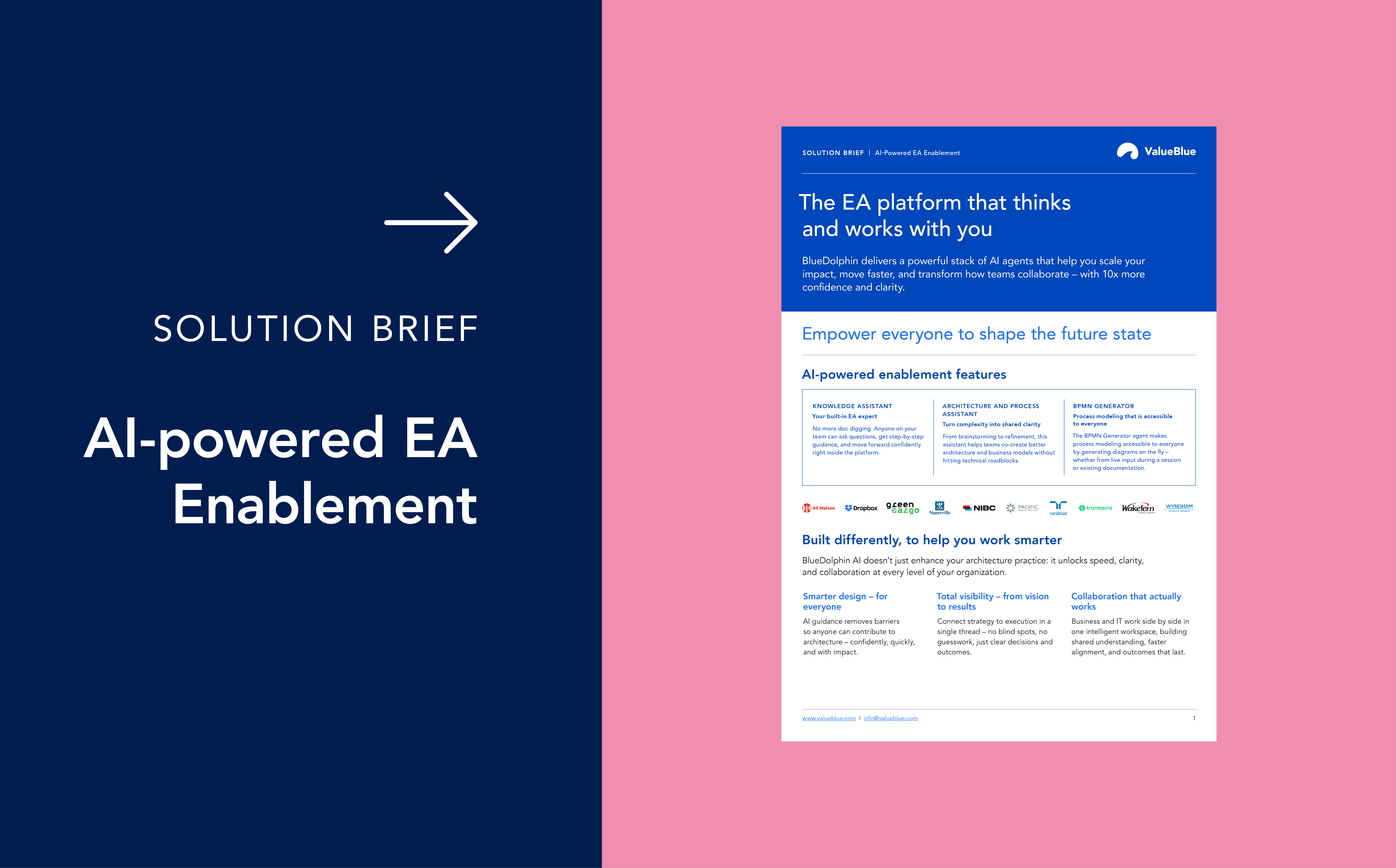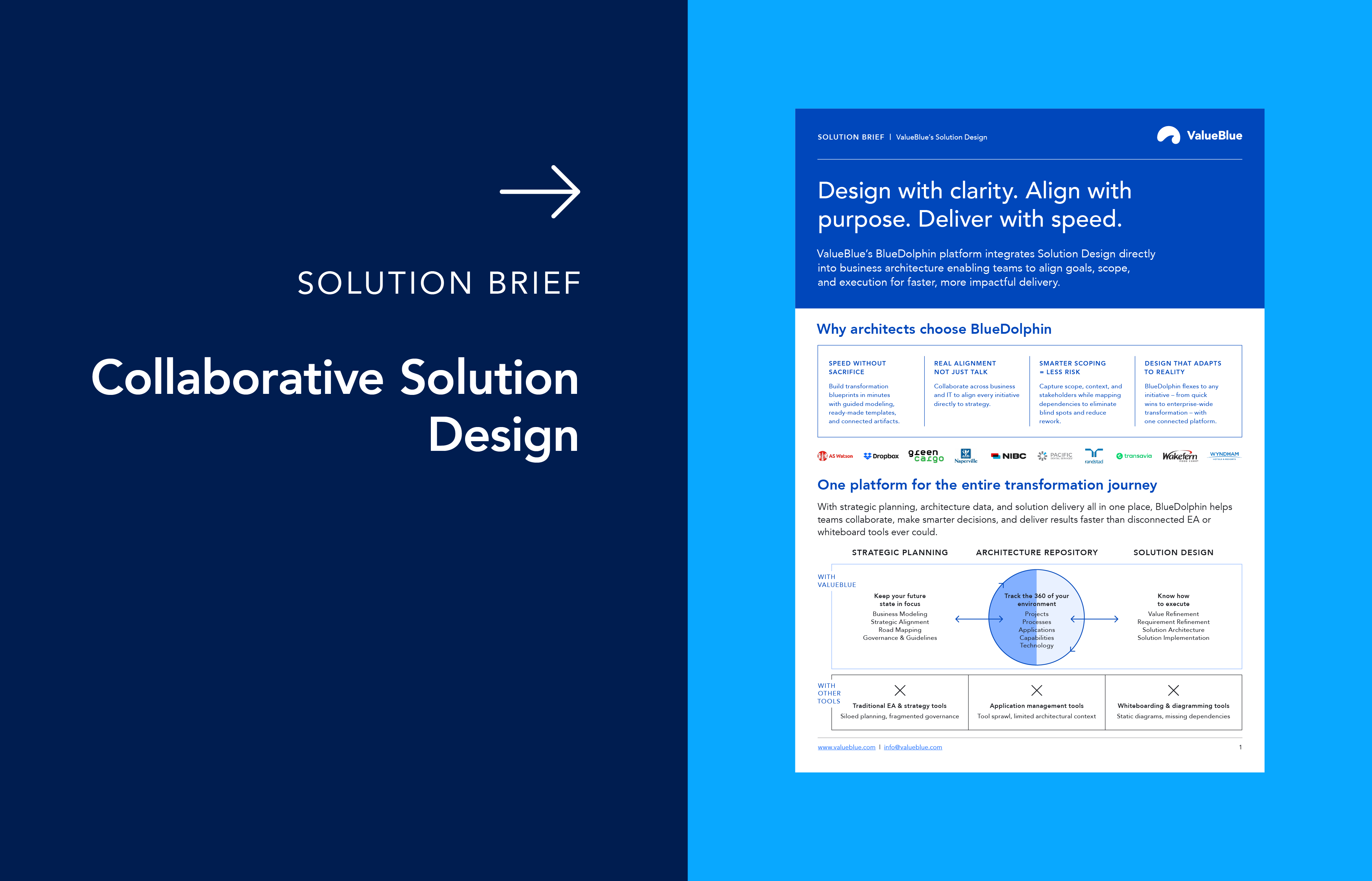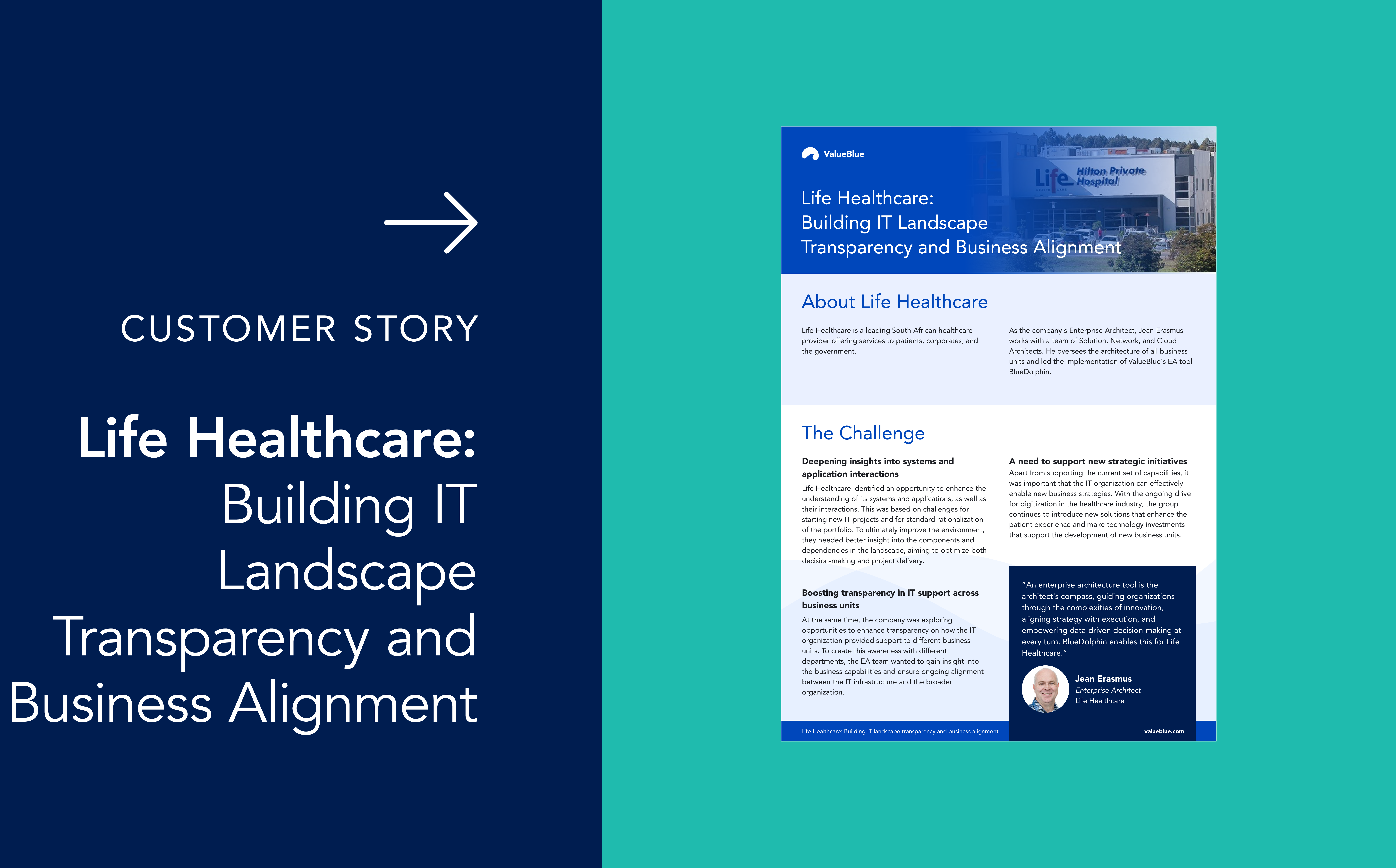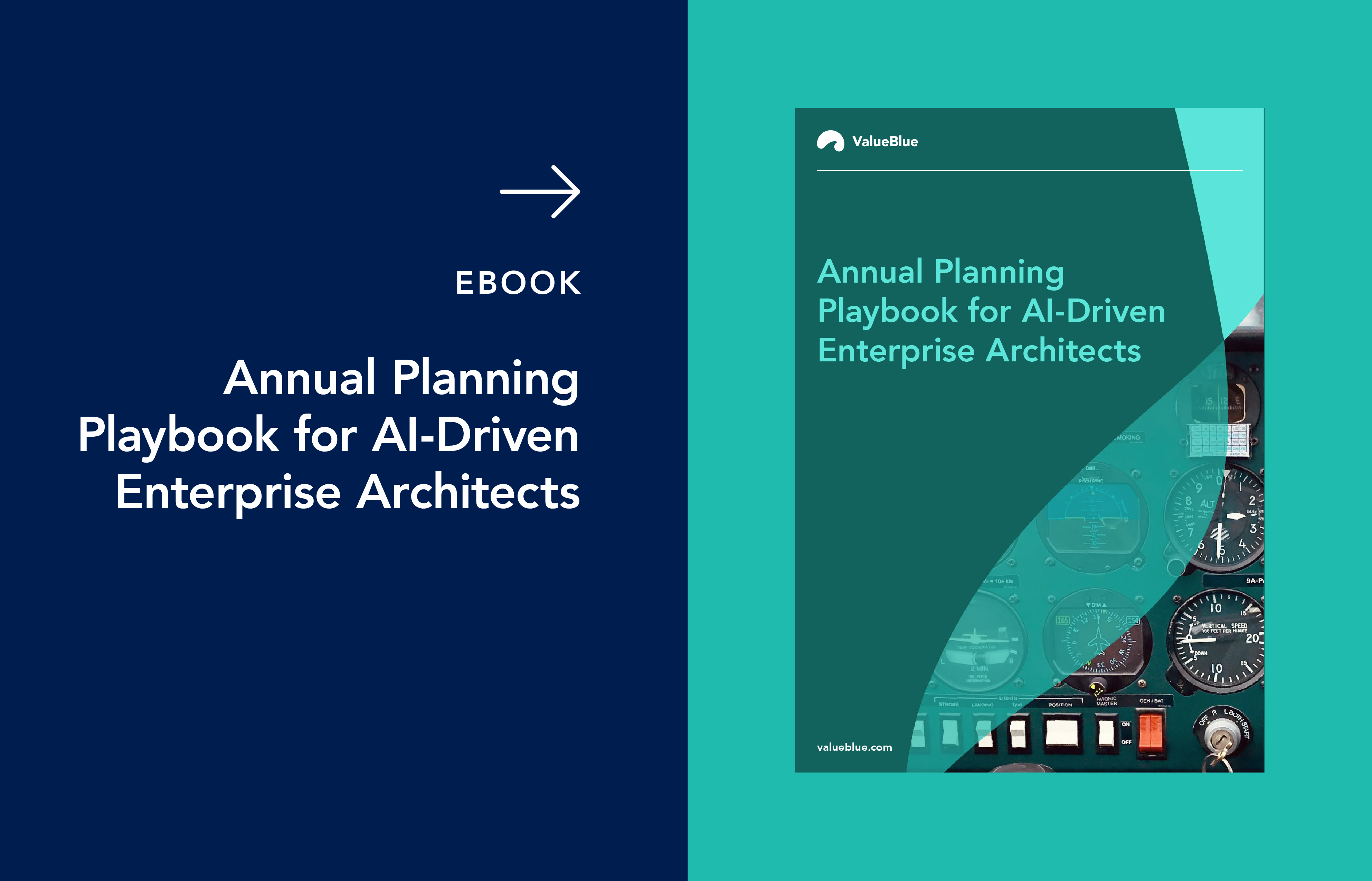Enterprise Architecture Tools: A Comprehensive Guide
In 2025, organizations are under pressure to align business vision with fast-moving technology change. The global Enterprise Architecture tools market was valued at $1,135.8 million in 2024 and is expected to grow at about 5.9 % annually through 2030.
The key word in Enterprise Architecture tools is enterprise. Their scope is bigger than IT. These platforms connect business vision and strategy with processes, applications, data, and infrastructure to give organizations a complete view. Unlike IT management platforms that only capture the current state, Enterprise Architecture tools allow leaders to model future states, evaluate the impact of change, and ensure technology choices support long-term business goals. In this guide we explain what Enterprise Architecture tools are, how they differ from other IT management platforms, and how to interpret the Gartner® Magic Quadrant™ when evaluating your options.
Table of contents
- What are Enterprise Architecture tools?
- Trends shaping the Enterprise Architecture tools market
- EA tools vs CMDBs
- Supporting TOGAF® and other frameworks
- How Enterprise Architecture tools support impact analysis
- How to choose the right EA tool
- Interpreting the Gartner® Magic Quadrant™
- Common adoption mistakes to avoid
- Key takeaways
What are Enterprise Architecture tools?
Unlike IT management platforms, which primarily track the current state of infrastructure, IT Enterprise Architecture tools create a foundation to design both current and future states of the business. They serve as the “glue” that links strategy to fine-grained architecture, answering questions such as:
- Which processes rely on which IT systems, and where can we drive efficiency?
- What data is being accessed, and how does that align with regulatory or security requirements?
- How will a new application or business capability affect the wider technology landscape?
In practice, this means IT Enterprise Architecture tools:
- Support impact analysis and assessments across processes, data, and IT portfolios.
- Connect strategy to execution by mapping how processes depend on applications and infrastructure.
- Enable sketching, modeling, and discussions about future states and innovations – capabilities IT management tools rarely support.
Trends shaping the Enterprise Architecture tools market
According to the Gartner Hype Cycle for Enterprise Architecture, three key themes are shaping the next phase of EA’s evolution:
1. Architecting the Future: EA teams are moving from mapping what exists to proactively shaping what comes next. This includes building AI reference models, designing value streams, creating product architectures, and planning for resilience. The focus is on ensuring architectures are adaptable to long-term strategic goals.
2. Orchestrating Modernization and Transformation: As organizations modernize, EA tools are becoming the coordination layer between business and IT. Capabilities like AI governance, platform engineering, automation, and roadmapping allow enterprises to align transformation initiatives with measurable business outcomes.
3. Enhancing EA Performance: The discipline of Enterprise Architecture is expanding its influence. Automated governance, AI literacy, and exposure evaluation are making EA more actionable. At the same time, non-IT stakeholders – from business managers to consultants – are increasingly empowered to participate in architecture activities.
There are also broader shifts in how EA tools are being used:
- Organizations are moving away from “point solutions” that only analyze IT, recognizing that Enterprise Architecture must be part of long-term planning.
- Software and consulting firms are adopting EA tools to design business support systems and construct product architectures for their clients, extending the value of Enterprise Architecture beyond internal use.
- EA practices are becoming more product-led and innovation-focused, with a solid foundation of architecture principles supporting faster, more agile delivery.
Enterprise Architecture tools are evolving from static documentation systems into dynamic platforms that enable innovation, transformation, and enterprise-wide collaboration.
Download our eBook A Practical Guide to Building Up Your Enterprise Architecture Practice to learn proven steps from 80 organizations.
EA tools vs CMDBs
A common question is how IT Enterprise Architecture tools compare with Configuration Management Databases (CMDBs). The difference comes down to purpose, perspective, audience, and even the way information is presented.
- Enterprise Architecture tools are designed for strategic planning. They span business capabilities, processes, applications, data, and infrastructure, giving architects, CIOs, consultants, and analysts a long-term view of the enterprise. EA tools support impact assessments, modeling of future states, and design of transformation initiatives. Information can be explored in many formats, including diagrams, matrices, and reports, making it easier to engage both technical and business stakeholders.
- Configuration Management Databases are operational by nature. They catalog deployed assets such as servers, devices, networks, and software. CMDBs are used by IT managers, service managers, and infrastructure teams to manage the day-to-day environment. Their data is typically presented in list or catalog formats that show what is running right now.
The two serve different needs but are stronger together. A CMDB’s “live” list of assets feeds the operational reality, while an Enterprise Architecture tool puts that information in context and projects its impact on the business. Integrations, such as BlueDolphin’s out-of-the-box ServiceNow connector, make this possible. By automatically bringing CMDB data into the EA landscape, organizations avoid manual entry, gain a more accurate current-state picture, and can use the Enterprise Architecture tool to run impact assessments and plan future change with confidence.
Here’s a quick comparison that highlights the differences at a glance:

Watch our webinar to see how Enterprise Architecture helps identify and reduce IT risk while aligning with business goals.
Supporting TOGAF® and other frameworks
Enterprise Architecture frameworks such as TOGAF® (The Open Group Architecture Framework) provide a valuable structure for aligning business and IT, but they are not the end goal. Frameworks should be treated as a means to an end, not a rigid rulebook. Following them too closely can lead teams to lose sight of actual outcomes and business value.
This is where IT Enterprise Architecture tools add real value. As TOGAF® tools and other frameworks are embedded into the platform, teams can apply proven methods without getting bogged down in theory. At the same time, the best tools are flexible. They allow organizations to customize how frameworks are applied, so teams can adapt practices to their own culture, governance model, and maturity level.
Customization is critical because no two enterprises work the same way. A financial services firm might rely heavily on TOGAF® artifacts and governance structures, while a fast-moving SaaS company might need a lighter, more agile approach. With an EA tool, both can apply framework principles while shaping them to fit their reality. This ensures the framework supports decision-making and innovation instead of dictating it.
Ultimately, the value of Enterprise Architecture implementation tools lies not in enforcing a single methodology, but in giving organizations the flexibility to align strategy and execution in a way that makes sense for their business.
How Enterprise Architecture tools support impact analysis
One of the most powerful capabilities of Enterprise Architecture tools is impact analysis. Whenever an organization considers a technology or process change, leaders need to know not only what exists today, but also how proposed changes will affect the business tomorrow.
Enterprise Architecture tools make this possible by:
- Modeling future scenarios: Teams can sketch and test ideas before committing resources, from adding a new application to redesigning an entire value stream.
- Revealing dependencies: By mapping how processes rely on specific applications or infrastructure, EA tools show where efficiency can be gained or risks introduced.
- Evaluating risk and compliance: EA tools expose which data is being accessed, by which systems, and whether those flows align with regulations and internal policies.
- Bridging IT and business goals: Instead of focusing only on technical infrastructure, impact analysis in EA tools connects proposed changes back to strategic outcomes, ensuring technology investments directly support business priorities.
Unlike IT management platforms that primarily capture the “right now”, Enterprise Architecture tools give organizations the ability to look ahead. They provide a structured way to anticipate the ripple effects of decisions and build a clear path from current state to future vision. This forward-looking perspective is what turns change from a reactive exercise into a proactive strategy.
How to choose the right EA tool
Selecting an Enterprise Architecture tool is not about chasing the longest list of features. The real measure is how well the tool supports business outcomes and aligns with organizational goals. The evaluation process should start with clarity of purpose, not a vendor comparison chart.
When evaluating Enterprise Architecture tools, you should:
- Define outcomes and business value first: Know what you want to achieve, whether it is reducing costs, improving compliance, enabling faster innovation, or aligning IT with business capabilities. Tools are only as valuable as the outcomes they help deliver.
- Secure executive buy-in early: EA tool adoption requires support beyond the architecture team. CIOs and business leaders must understand the value and commit to using insights from the tool in decision-making.
- Involve multiple stakeholders: Enterprise Architecture is not just for architects. Business analysts, portfolio managers, consultants, and IT leaders should all have a say in tool requirements, ensuring the chosen platform serves the broader enterprise.
- Avoid the “bucket list” trap: A long wish list of features can create noise. Instead, compare vendors on consistent criteria tied to your organization’s real needs – “apples to apples” rather than “apples to everything.”
- Evaluate the vendor’s vision and cultural fit: An EA tool is not just software, it is a partnership. Consider how the vendor views the role of Enterprise Architecture, how their roadmap aligns with your direction, and whether their culture complements your own.
Alongside your internal evaluation, industry research can be a helpful guide. The Gartner® Magic Quadrant™ is often the first resource teams turn to, but consider balancing it with Gartner’s Critical Capabilities report. The Magic Quadrant highlights vendor positioning in the market, while the Critical Capabilities analysis dives deeper into how well tools perform against specific use cases. Looking at both ensures you are choosing not only a recognized vendor, but also one whose strengths align with your organization’s priorities.
Interpreting the Gartner® Magic Quadrant™
The Gartner® Magic Quadrant™ for Enterprise Architecture tools is one of the most recognized resources in the market, but it should never be the sole basis for a decision. The MQ is a starting point for conversations with vendors, not the end of the evaluation.
Hot off the press! Access the 2025 Gartner® Magic Quadrant™ for Enterprise Architecture Tools.
A few key considerations stand out:
- Look beyond the Leaders quadrant: It is tempting to focus only on the vendors in the top right, but those high-maturity tools may not suit every organization. Sometimes a Visionary or Niche Player may offer a better cultural fit, more flexibility, or a roadmap that aligns more closely with your goals.
- Balance the Gartner® Magic Quadrant™ with the Critical Capabilities report: The MQ shows a company’s overall market position, while the Critical Capabilities report drills into how tools perform against specific use cases. Reviewing both ensures you are comparing vendors on the factors that matter most to your enterprise.
In short, the Gartner® Magic Quadrant™ is a useful tool to frame the market, but the real value comes from using it as a springboard to deeper analysis and vendor discussions.
Common Enterprise Architecture tool adoption mistakes to avoid
Adopting an Enterprise Architecture tool can deliver major value, but only if it is approached strategically. Our SMEs see a few common pitfalls that organizations should avoid:
- Treating EA as only application portfolio management: The word is enterprise. Limiting scope to applications misses the broader perspectives of business capabilities, processes, and data that make Enterprise Architecture valuable.
- Focusing only on the current state: IT management platforms already show what exists today. The real strength of Enterprise Architecture implementation tools is their ability to design and test future states.
- Leaving out business stakeholders: EA tools are not just for architects and IT teams. Involving non-technical stakeholders early ensures adoption aligns with business priorities and avoids disconnect.
- Trying to do too much at once: Ambitious rollouts often overwhelm teams and create resistance. A better approach is to start small – for example, by modeling a single project or change – and use that quick win to build credibility and governance.
- Concentrating on features instead of value: Features are only a means to an end. Keep stakeholders front of mind and evaluate tools based on the outcomes they help deliver, such as cost efficiency, compliance, or faster innovation.
Key takeaways
- Enterprise Architecture tools connect business strategy to technology execution.
- They complement but differ from CMDBs by focusing on strategy, not operations.
- Adoption requires clear outcomes, stakeholder buy-in, and starting small.
- Gartner® Magic Quadrant™ is useful but should be read alongside use-case analysis.
- Trends like AI governance, automation, and resilience planning are shaping the EA landscape.
Ready to see how ValueBlue can help your team plan smarter with Enterprise Architecture tools? Book a demo today.
FAQ
1. What are Enterprise Architecture tools?
They are platforms that help organizations plan and design current and future states of business and technology, enabling strategy-to-execution alignment.
2. How do Enterprise Architecture tools differ from CMDBs?
Enterprise Architecture tools are strategic and focus on future planning, while CMDBs are operational and track current IT assets.
3. How do Enterprise Architecture tools support TOGAF®?
They provide a structure for applying frameworks like TOGAF® while allowing flexibility and customization.
4. What are impact analysis tools in Enterprise Architecture?
They allow teams to model changes, assess risks, and predict business impact before implementing changes.
5. How should companies useGartner® Magic Quadrant™ for Enterprise Architecture tools?
Use it as a starting point for vendor evaluation, but also review the Critical Capabilities report and assess cultural fit.





